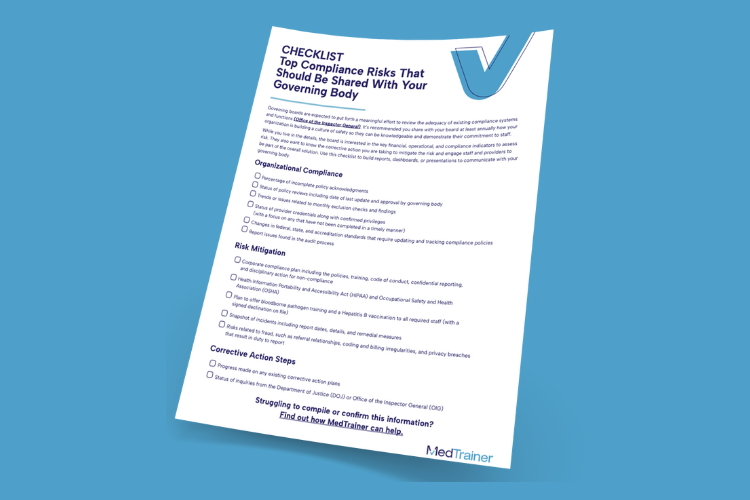As healthcare continues to benefit from digital innovation, more and more software applications are becoming part of the ecosystem — healthcare risk management software among them. This critical software is a cornerstone in healthcare organizations because of how important it is within the realm of compliance. With the ability to manage risk and maintain compliance, it’s nothing short of mission-critical software.
Here’s a closer look at healthcare risk management software and the role it plays within healthcare organizations.
What Is Healthcare Risk Management Software, and Why Is It Necessary?
Healthcare risk management software assists healthcare organizations in identifying, assessing, and mitigating risks related to patient safety, regulatory compliance, and care operations. It serves as a comprehensive system for proactively managing risk across various areas, including medical errors, data breaches, legal and financial liabilities, and quality assurance.
Healthcare risk management software plays several key roles in risk management:
- Identify Risks. It empowers healthcare organizations to identify and address potential risks before they result in harm. The software helps identify patterns and trends by streamlining incident reporting and analysis. This allows providers to implement targeted interventions that improve the delivery of patient care.
- Understand Risks. Healthcare risk management software assists organizations in maintaining compliance with regulatory requirements and industry standards. For example, by providing tools for data privacy and security management, it can help providers adhere to laws and guidelines set forth by the Health Insurance Portability and Accountability Act (HIPAA).
- Mitigate Risks. The software aids in risk mitigation strategies, reducing the potential for legal and financial repercussions. By identifying risks, documenting them, and documenting steps to remediate them, organizations can show their commitment to continuous improvement. This can reduce the burden of liability.
Overall, healthcare risk management software promotes a proactive and systematic approach to risk identification, assessment, and mitigation, ultimately contributing to improved patient outcomes and organizational performance.

Make sure you're sharing the right compliance information with your board.
How Does Healthcare Risk Management Software Help Organizations Identify and Mitigate Risks?
Healthcare risk management software assists organizations in identifying and mitigating risks through several key functions, including:
- Incident Reporting and Tracking. Software provides a centralized platform for healthcare professionals to report incidents, near misses, and adverse events. It captures relevant details such as date, time, location, individuals involved, and the nature of the incident.
- Risk Assessment. Healthcare risk management software typically includes tools for conducting risk assessments. These assessments help identify potential risks, evaluate their likelihood and impact, and prioritize them based on severity. By using standardized risk assessment methodologies, organizations can systematically evaluate risks across different areas, such as patient safety, data security, and regulatory compliance.
- Compliance Management. The software helps organizations stay compliant with complex regulatory requirements and industry standards. It can include tools for tracking compliance training, audits, and corrective actions, enabling organizations to address any gaps and mitigate risks related to regulatory non-compliance.
- Analytics and Reporting. Robust analytics and reporting capabilities allow organizations to generate comprehensive reports and dashboards that provide insight into risk trends, key performance indicators, and areas that require attention. Reporting is also critical during compliance audits, both internal and external.
- Communication and Collaboration. Software acts as a communication and collaboration medium for sharing information, documenting action, and ensuring transparency. A collaborative approach facilitates the identification and resolution of risks across the healthcare team.
Through these core functions (and others), healthcare risk management software empowers organizations to identify risks in a timely manner, assess their potential impact, and implement appropriate mitigation strategies. This proactive approach helps prevent adverse events, enhance patient safety, maintain regulatory compliance, and ultimately, improve facility compliance.
Key Features and Functionalities of Healthcare Risk Management Software
The features and capabilities of healthcare risk management software are what make it valuable to healthcare organizations using it. This typically includes incident reporting and tracking, risk assessment, compliance management, policy and procedure documentation, training and education modules, and analytics and reporting capabilities.
Here’s a look at how these key features (and others) come together — and what to look for when selecting a healthcare risk management platform:
Incident Reporting, Tracking, and Investigation
Online incident reports track incidents automatically, so you can identify trends and risks before they become habitual problems. This function enables organizations to identify patterns, trends, and potential areas of risk. Reporting also improves investigation processes by streamlining data collection, analysis, and root cause determination, which helps facilities and auditors understand why incidents occurred and what was done to remediate them.
Includes a Learning Management System
A learning management system (LMS) is valuable for training and education related to risk mitigation. An LMS with onboarding capabilities allows organizations to group and automatically assign role-specific training modules, along with policies and procedures to employees for acknowledgement. Always look for an LMS that prioritizes controls for assigning, tracking, and reminding staff about modules they need to complete.
Customizable Reporting and Dashboards
Customizable reporting and dashboards pave the way for tailored reports and visualizations that quantify key risk indicators. Risk managers and compliance officers can define specific metrics, parameters, and data points to be included in the reports. Make sure the software you choose has customizable dashboards that provide a consolidated view of risk-related data: incident trends, compliance status, and more.
Automated Workflows
Automated workflows streamline and standardize risk management processes, while reducing the administrative burden on compliance officers and risk management professionals. Look for software that automates tasks and notifications for incident reporting, investigations, risk assessments, and mitigation processes. Ultimately, automation makes it easier to escalate incident reports and responses, which results in quicker resolution.
There’s No Substitute for Risk Management
Risk is a four-letter word in healthcare, which makes it one to avoid whenever possible. The best way to get away from risk? Address it head-on. Healthcare organizations that prioritize risk management will see fewer instances of adverse events and a higher standard of compliance.
Healthcare risk management software is at the root of it all. Whether you’re seeking to address specific risk trends in a facility or standardize compliance across your entire organization, MedTrainer offers the tools you need to minimize risk. Schedule a demo today and see for yourself!
